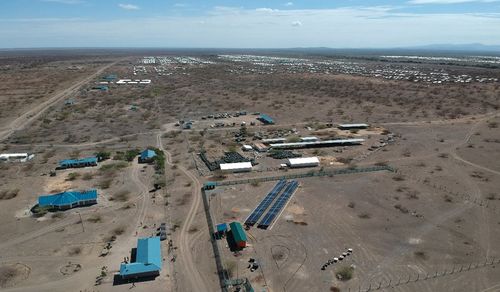Click here to register!
Difference between revisions of "Expanding mini-grids during Covid-19 – Experiences from Kalobeyei"
***** (***** | *****) m |
***** (***** | *****) m (→Article) |
||
| Line 5: | Line 5: | ||
In the Kalobeyei Settlement and host community town, ESDS Kenya supported the Covid-19 response measures of the local authorities by connecting facilities to the two existing mini-grids. In total, 3 health facilities, providing medical serivces to refugees and host community, 4 schools, earmarked as isolation centers, and one horticultural farm run by WFP which sustains the food supply, were connected to the mini-grids. While these measures serve as immediate contribution to efforts to contain the pandemic, they also improve the energy services in Kakuma long-term wise and align with the broader objective of ESDS. [[File:Minigrid Kalobeyei.jpg|thumb|center|500px|Mini-Grid in Kalobeyei.Source: Renewvia Energy]]<br/> | In the Kalobeyei Settlement and host community town, ESDS Kenya supported the Covid-19 response measures of the local authorities by connecting facilities to the two existing mini-grids. In total, 3 health facilities, providing medical serivces to refugees and host community, 4 schools, earmarked as isolation centers, and one horticultural farm run by WFP which sustains the food supply, were connected to the mini-grids. While these measures serve as immediate contribution to efforts to contain the pandemic, they also improve the energy services in Kakuma long-term wise and align with the broader objective of ESDS. [[File:Minigrid Kalobeyei.jpg|thumb|center|500px|Mini-Grid in Kalobeyei.Source: Renewvia Energy]]<br/> | ||
| + | |||
== Article<br/> == | == Article<br/> == | ||
| − | The Kakuma Refugee Camp and the Kalobeyei Integrated Settlement, located in Turkana County at the north-western border of Kenya, currently host close to 200,000 refugees from Eastern and Central Africa. Albeit donors and humanitarian organizations installed mini-grids and the nearby Kakuma town is connected to a sub-station of the national grid, only | + | The Kakuma Refugee Camp and the Kalobeyei Integrated Settlement, located in Turkana County at the north-western border of Kenya, currently host close to 200,000 refugees from Eastern and Central Africa. Albeit donors and humanitarian organizations installed mini-grids and the nearby Kakuma town is connected to a sub-station of the national grid, only 5% of households in the camps had reliable access to electricity in 2019 according to UNHCR, while many systems, including the sub-station, run on diesel-Generators. |
| + | [[Category:Kenya]] | ||
| + | [[Category:Mini-grid]] | ||
[[Category:Humanitarian_Energy]] | [[Category:Humanitarian_Energy]] | ||
| − | |||
| − | |||
Revision as of 09:26, 9 October 2020
Overview [Draft]
In the Kalobeyei Settlement and host community town, ESDS Kenya supported the Covid-19 response measures of the local authorities by connecting facilities to the two existing mini-grids. In total, 3 health facilities, providing medical serivces to refugees and host community, 4 schools, earmarked as isolation centers, and one horticultural farm run by WFP which sustains the food supply, were connected to the mini-grids. While these measures serve as immediate contribution to efforts to contain the pandemic, they also improve the energy services in Kakuma long-term wise and align with the broader objective of ESDS.
Article
The Kakuma Refugee Camp and the Kalobeyei Integrated Settlement, located in Turkana County at the north-western border of Kenya, currently host close to 200,000 refugees from Eastern and Central Africa. Albeit donors and humanitarian organizations installed mini-grids and the nearby Kakuma town is connected to a sub-station of the national grid, only 5% of households in the camps had reliable access to electricity in 2019 according to UNHCR, while many systems, including the sub-station, run on diesel-Generators.




















